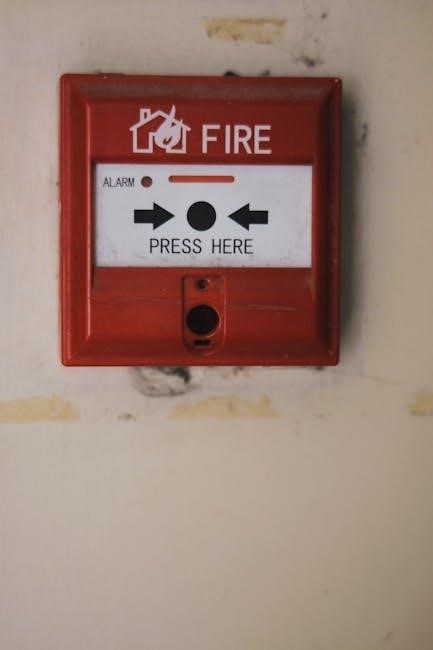
A manual handling risk assessment identifies and evaluates tasks involving lifting, pushing, or pulling to prevent injuries․ It ensures a safe working environment by addressing potential hazards early․
1․1 Definition and Purpose
A manual handling risk assessment is a systematic process to identify and evaluate tasks that involve lifting, pushing, pulling, or carrying loads, which could pose risks of injury․ Its primary purpose is to prevent work-related musculoskeletal disorders by highlighting hazardous tasks and implementing control measures․ This assessment ensures compliance with legal requirements and promotes a safer working environment by addressing potential risks proactively․ It is essential for all industries, including healthcare, manufacturing, and logistics, where manual tasks are common․
1․2 Importance of Conducting Regular Risk Assessments
Regular manual handling risk assessments are crucial for preventing work-related injuries and ensuring legal compliance․ They help identify potential hazards, allowing employers to implement control measures and reduce risks․ By addressing unsafe practices early, organizations can improve workplace safety, minimize downtime, and lower costs associated with injuries․ Regular assessments also demonstrate a commitment to employee well-being and foster a culture of safety within the organization․ Consistent evaluations ensure ongoing protection for workers in dynamic environments․

Key Steps in a Manual Handling Risk Assessment
Identify hazards, assess risks, and implement control measures to minimize injury risks․ Regular monitoring ensures ongoing safety and compliance with workplace standards and legal requirements․
2․1 Step 1: Identify the Hazards
Identifying hazards involves recognizing tasks that may cause injury, such as lifting heavy loads, awkward postures, or repetitive movements․ Assess the environment, load characteristics, and individual capabilities to pinpoint risks early․
2․2 Step 2: Determine Who Might Be Harmed and How
This step identifies individuals at risk, such as employees performing manual tasks, and assesses how they might be harmed․ Consider factors like physical strain, awkward postures, and pre-existing health conditions to evaluate potential injuries and their severity․
2․3 Step 3: Evaluate the Risks
Evaluating risks involves analyzing identified hazards to determine their severity and likelihood․ Consider factors like load weight, awkward postures, and environmental conditions․ Tools like the MAC tool help categorize risks as high, medium, or low․ This step prioritizes risks, ensuring high-risk tasks are addressed first to minimize injury potential․ It’s crucial for developing effective control measures․
2․4 Step 4: Implement Control Measures
Implementing control measures involves taking actionable steps to reduce or eliminate identified risks․ This may include ergonomic adjustments, using mechanical aids like hoists, or modifying tasks to reduce physical strain․ Training employees on proper lifting techniques and ensuring a safe workspace layout are also key․ Regular monitoring ensures controls remain effective, fostering a safer environment and reducing manual handling injuries over time․
2․5 Step 5: Monitor and Review
Monitoring and reviewing the risk assessment ensures that control measures remain effective over time․ Regular inspections and feedback from employees help identify new risks or changes in tasks․ Reviews should be scheduled or triggered by incidents, changes in processes, or updated regulations․ Documentation of reviews ensures accountability and continuous improvement․ This step is crucial for maintaining a safe work environment and adapting to evolving workplace conditions, ultimately reducing manual handling injuries and promoting legal compliance․

Risk Factors to Consider
Risk factors include task demands, load characteristics, workplace environment, and individual capabilities․ Addressing these elements helps minimize injuries and ensures safer manual handling practices․
3․1 Task-Related Factors (e․g․, lifting, pushing, pulling)
Task-related factors, such as lifting, pushing, or pulling, are critical in manual handling risk assessments․ These actions often involve repetitive motions, awkward postures, or sustained force, increasing injury risks․ For example, lifting heavy loads above shoulder height or pulling objects from low spaces can strain muscles․ Assessing these factors helps identify high-risk tasks and implement targeted control measures to reduce workplace injuries and enhance safety․
3․2 Load-Related Factors (e․g․, weight, size, shape)
Load-related factors, such as weight, size, and shape, significantly impact manual handling risks․ Heavier loads increase strain, while bulky or awkwardly shaped items can make handling unstable․ For instance, a large box with uneven weight distribution may be difficult to grip and maneuver, raising injury risks․ Evaluating these factors helps in determining appropriate handling techniques and control measures to mitigate potential harm and ensure safer manual handling practices in the workplace․
3․3 Environmental Factors (e․g․, workspace layout, lighting)
Environmental factors, such as workspace layout and lighting, play a crucial role in manual handling safety․ A cluttered or poorly designed workspace can obstruct movement, increasing the risk of accidents․ Inadequate lighting may hide obstacles or make it difficult to see the load clearly․ Additionally, uneven or slippery floor surfaces can lead to slips or falls while handling loads․ Addressing these environmental factors is essential to creating a safer working environment and reducing manual handling risks․
3․4 Individual Factors (e․g․, physical capabilities, health conditions)
Individual factors, such as physical capabilities and health conditions, significantly influence manual handling risks․ Employees with pre-existing injuries or conditions like back problems may be more susceptible to harm․ Physical strength, flexibility, and endurance also play a role․ It is crucial to assess each worker’s abilities and tailor tasks accordingly․ Ignoring these factors can lead to musculoskeletal disorders and other injuries, emphasizing the need for personalized evaluations in the risk assessment process․

Tools and Resources for Risk Assessment
Utilize tools like the MAC Tool, risk assessment templates, and examples to evaluate manual handling risks effectively․ These resources guide systematic evaluations and control implementations․
4․1 The Manual Handling Assessment Chart (MAC Tool)
The MAC Tool helps assess manual handling risks by evaluating factors like weight, distance, and body posture․ It categorizes tasks as low, medium, or high risk, guiding control measures․ Widely used, it ensures tasks are modified to reduce injury risks, promoting a safer workplace․ Employers often apply it to identify hazards and implement effective solutions․
4․2 Risk Assessment Templates and Examples
Risk assessment templates simplify the evaluation process by providing structured formats to document manual handling hazards and control measures․ Examples include task-specific checklists, hazard identification forms, and prioritization matrices․ These tools guide employers in systematically identifying risks, such as repetitive lifting or awkward postures, and implementing solutions․ Templates often include sections for task descriptions, risk factors, and control measures, ensuring comprehensive and consistent assessments․ They are invaluable for reducing manual handling injuries in various workplaces․

Examples of Manual Handling Risk Assessments
This section provides examples of manual handling risk assessments, including workplace scenarios and case studies․ It covers tasks like lifting heavy objects and repetitive movements, demonstrating how to evaluate risks using tools like the MAC tool and implement controls to reduce hazards․
5․1 Workplace Scenarios and Their Assessments
Workplace scenarios, such as lifting heavy boxes in a warehouse or pushing crates in a retail setting, are assessed for manual handling risks; For example, lifting heavy items from low spaces increases injury risks due to bending and stooping․ Assessments identify hazards like awkward postures, load weights, and workspace layout․ Controls such as mechanical aids, task redesign, or employee training are implemented to mitigate risks, ensuring safer practices and reducing injury likelihood in these common workplace tasks․
5․2 Case Studies and Real-World Applications
A hospital reduced manual handling injuries by 40% after assessing patient lifting tasks․ They implemented ergonomic equipment and staff training․ Similarly, a manufacturing plant lowered risks by 30% by replacing heavy manual tasks with mechanical aids․ These case studies highlight how systematic risk assessments and targeted controls can significantly reduce workplace injuries and improve overall safety in diverse industries, demonstrating practical applications of manual handling risk assessments․
Legal Requirements and Compliance
Manual handling risk assessments are legally required to ensure compliance with health and safety regulations, protecting employees from injury and employers from legal liabilities effectively․
6․1 Relevant Legislation and Guidelines
Manual handling risk assessments must comply with the Manual Handling Operations Regulations 1992 and HSE guidelines․ Employers are legally required to identify and reduce risks, ensuring tasks are safe․ The regulations emphasize evaluating tasks, implementing controls, and training employees․ Non-compliance can result in legal action and fines․ Adhering to these standards protects both workers and employers, fostering a safer workplace environment․
6․2 Employer Responsibilities and Employee Obligations
Employers must conduct thorough risk assessments, implement controls, and provide proper training to employees․ They are responsible for ensuring a safe work environment and maintaining equipment․ Employees must follow safety procedures, report hazards, and cooperate with employers to reduce risks․ Both parties share the obligation to prioritize health and safety, fostering a collaborative approach to prevent manual handling injuries and maintain compliance with legal standards․

Best Practices for Reducing Manual Handling Risks
Implement ergonomic workplace designs, provide proper training, and use mechanical aids to minimize manual handling risks․ Encourage employee involvement in identifying and mitigating hazards effectively․
7․1 Ergonomic Workplace Design
Ergonomic workplace design focuses on optimizing workspaces to reduce manual handling risks․ Adjust workstations to fit employees’ needs, ensuring proper posture and minimizing reaching or bending․ Use ergonomic tools and equipment designed to reduce strain․ Improve lighting to enhance visibility and prevent accidents caused by poor conditions․ Regularly assess and modify layouts to accommodate task requirements and employee feedback, fostering a safer and more efficient work environment․
7․2 Proper Training and Education
Proper training and education are essential for reducing manual handling risks․ Provide employees with clear guidelines on safe lifting techniques, posture, and task-specific hazards․ Include practical demonstrations and hands-on training to ensure understanding․ Regular refresher courses help maintain awareness and adapt to new equipment or procedures․ Tailor training to individual roles and physical capabilities, ensuring all staff can perform tasks safely and effectively, thus minimizing injury risks and promoting a culture of safety․
7․3 Use of Mechanical Aids and Equipment
The use of mechanical aids and equipment is a highly effective way to reduce manual handling risks․ Tools such as hoists, conveyors, and trolleys can significantly minimize physical strain․ Employers should select appropriate equipment tailored to the task, ensuring it is well-maintained and regularly inspected․ Training staff on proper usage is crucial to maximize safety benefits․ While mechanical aids reduce risks, they should be combined with proper training and ergonomic practices for optimal results, ensuring a safer and more efficient work environment․

Documentation and Record-Keeping
Accurate records of risk assessments must be maintained, detailing hazards, control measures, and review dates․ Proper documentation ensures compliance with legal requirements and facilitates traceability of decisions made․
8․1 Maintaining Accurate Risk Assessment Records
Maintaining accurate records of manual handling risk assessments is crucial for compliance and accountability․ Records should include details of the task, hazards identified, control measures implemented, and review dates․ Employers must ensure documentation is readily accessible to relevant parties, including employees and inspectors․ Accurate records also facilitate traceability of decisions and actions taken to mitigate risks․ Proper storage and regular updates ensure the integrity of the assessment process and support legal compliance․ Involving employees in documenting their tasks enhances accuracy and accountability․
8․2 Reporting and Review Processes
Regular reporting and review processes ensure manual handling risk assessments remain effective․ Employers must report significant findings to relevant stakeholders and update records post-review․ Reviews should occur periodically, such as every six months or after incidents․ Employees involved in tasks should contribute to reviews, providing insights into operational challenges․ Updates to risk assessments and control measures are documented to reflect changes in tasks or workplace conditions․ This continuous process ensures ongoing compliance and safety improvements․
Implementing a robust manual handling risk assessment ensures workplace safety and legal compliance․ Continuous monitoring and employee engagement are crucial for sustaining a hazard-free environment and promoting well-being․
9․1 Summary of Key Takeaways
Manual handling risk assessments are essential for identifying hazards and reducing injuries․ Regular evaluations ensure tasks are safe, while tools like the MAC tool aid in prioritizing risks․ Training employees and using mechanical aids further mitigate dangers․ Continuous monitoring and adapting assessments to workplace changes are vital for long-term safety․ Employers must stay compliant with legal requirements and foster a culture of safety to protect workers and maintain efficiency in manual handling tasks․
9․2 Implementing and Sustaining a Safe Work Environment
Creating a safe work environment requires proactive measures, including regular training and the use of mechanical aids․ Employers must foster collaboration between employees and management to identify risks and implement solutions․ Continuous monitoring and feedback ensure sustained safety․ Utilizing tools like the MAC tool and risk assessment templates helps maintain consistency․ Regular reviews and updates to assessments are crucial to adapt to workplace changes and ensure ongoing compliance with legal requirements․